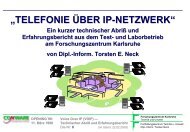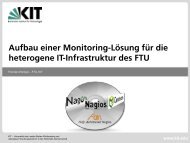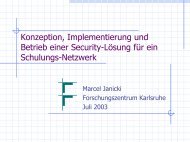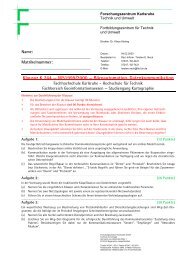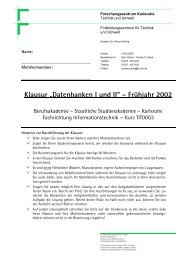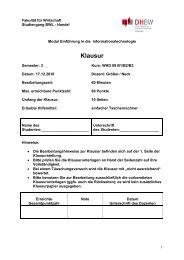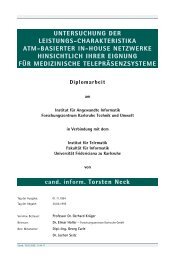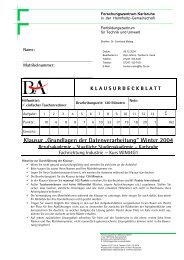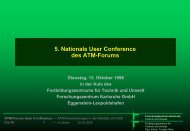Interner Brief - Torsten E. Neck
Interner Brief - Torsten E. Neck
Interner Brief - Torsten E. Neck
You also want an ePaper? Increase the reach of your titles
YUMPU automatically turns print PDFs into web optimized ePapers that Google loves.
2 Technical principals of the multi-point conference<br />
Point-to-multipoint visioconferences (abbreviated P2M in further) are quite similar to point-topoint<br />
(P2P) conferences. In fact they use the same end-systems as P2P. Thus all the<br />
recommendations and rules given for P2P systems are still valid for P2M systems, P2M can<br />
be seen as a natural evolution from the P2P technique by adding a single piece of valueadded<br />
hardware. As stated before, P2M technique only needs one additional hardware<br />
called 'MCU', multiconferencing unit.<br />
A MCU concentrates as many ISDN lines as needed to connect to each P2M partner with the<br />
appropriate bitrate. MCUs usually are scalable or they can be cascaded to extend the<br />
number of concurrently served partners. The scalability usually is independent from the<br />
number of available ISDN links. This means that it is possible to run for example a 16 party<br />
MCU on an ISDN PRI thus allowing the P2M interconnection of five partners at a quality of<br />
384 kbps or 15 partners at a quality of 128 kbps.<br />
A MCU in principle runs two functions:<br />
• it does set-up a P2P connection to each partner concurrently<br />
• it distributes the sound and video streams of one participant (who currently has got the<br />
focus) to all other participants.<br />
In consequence of that basic functionality P2M technique differently from P2P needs a<br />
session management to switch the focus among the communicating partners, which is<br />
provided by the MCU, too. The MCU therefor defines two tokens which represent two<br />
classes of rights granted to a partner, the first token stands for the focus in sound, the<br />
second token stands for the focus in video. Thus it is possible to deliver a common video<br />
stream concurrently to all participants derived from one partner but to have the audible<br />
comments on the video derived from a different partner and distributed to all other partners.<br />
Mainly there are two principals of managing these tokens:<br />
• an automatic token passing controlled by sound: both tokens are put to the partner who<br />
at last produced some sound at his site. This principle is excellent for controvers<br />
discussion among a small number of participants because there is no need of a<br />
dedicated session leader, but it needs a very good discipline at all partners, who are not<br />
allowed to produce any noise like snorring our shouts while another partner is speaking.<br />
• A manual token passing controlled by a session manager, who can pass the tokens<br />
indepentently to any partner.<br />
MCUs can be installed at one site in a consortium of frequently communicating partners (like<br />
in the TESUS network), but it is also possible to use a MCU in form of a service provided by<br />
a public carrier. The hardware in the latter case is out-sourced to the carriers location and the<br />
participants call at a special service line or they are called by the MCU. The session<br />
management, if not done in automatic mode, can be passed to one of the partners.<br />
As the endsystems in a P2M conference are the same systems which are deployed for P2P<br />
visioconferences there are still the same possiblities to connect audio-visual sources. If the<br />
end-system itself is not capable of connecting different sources directly, an analogue video<br />
switch (cross-bar) and an analogue audio mixer can be used as a multiplexer for different<br />
independent sources. Usually these cross-bars and mixers are remotelyx controllable via<br />
serial lines or TCP connections, which may allow every partner to interact with these devices.



